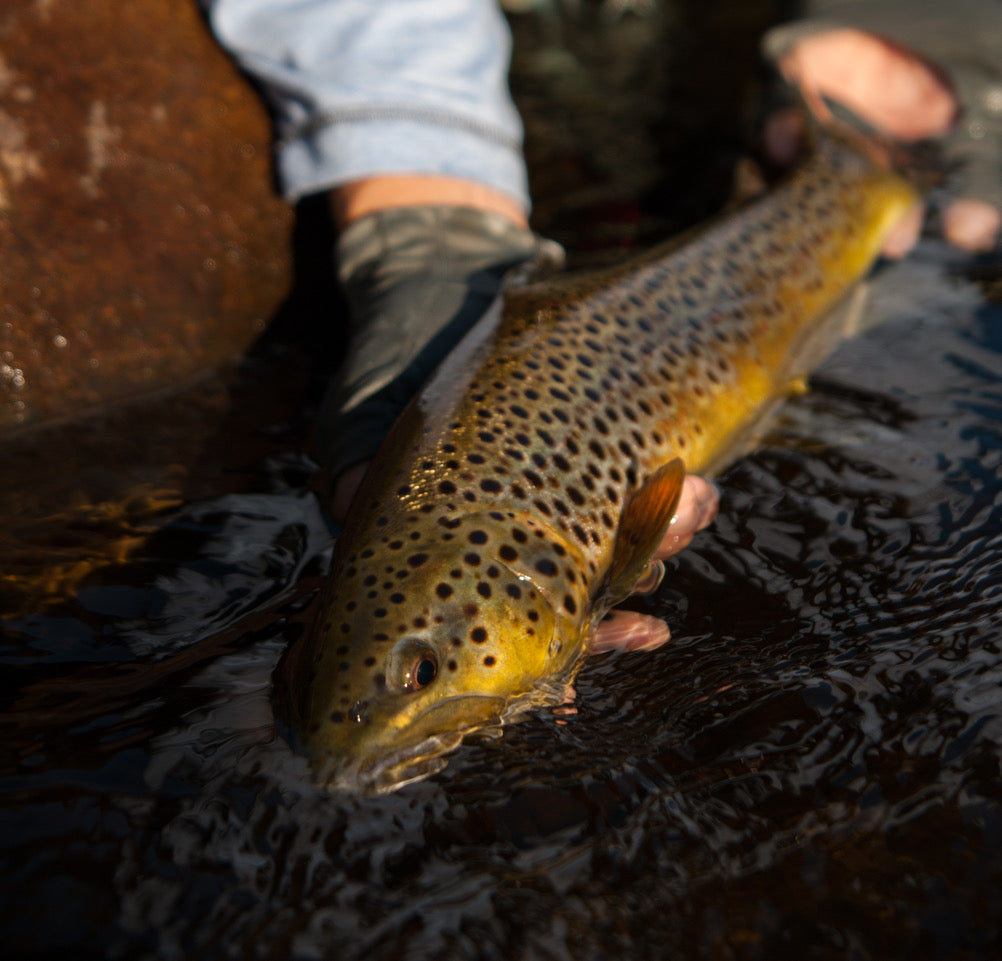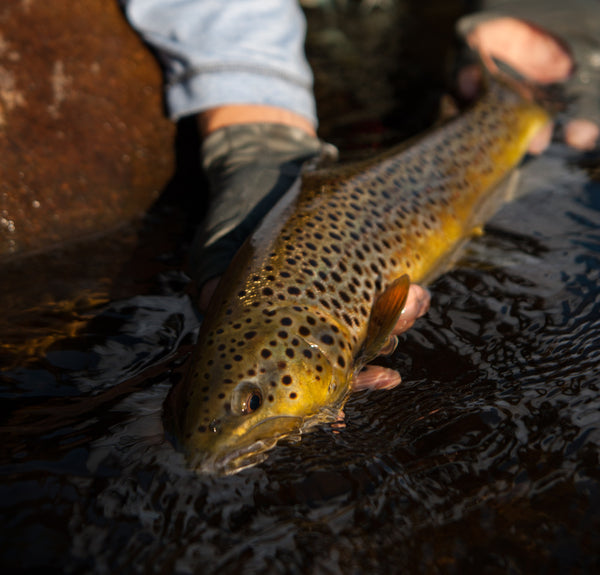Trout Fly Fishing: 3 Bad Habits to Break


As a Trout Guide I Like To Think That There Are No Mistakes in Fly Fishing, Rather There Are Learning Opportunities — Lots and Lots of Learning Opportunities
With each client I try to place an emphasis on proving yourself wrong, and by that I mean, take some rule/tactic/method and try to disprove it. After all, how many times have you done what was considered to be wrong and yet still caught a fish?
Habits on the other hand, are another story. Unlike mistakes, habits — especially a certain few — can be detrimental to catching trout. I'm going to address three of the worst habits I see on the water and how you can go about improving your habits to catch more trout.
1. Not Letting It Fish

Getting ready to fish the Nymph-Head Evolution Stonefly.
Your fly that is. Let your fly fish. Having just wrapped up another trout season, this may be the most important and prevalent bad habit I see.
You’ve found that pool or run or pocket that you have been waiting for all day and you cast, but your fly doesn’t land the way you envision and so you rip it off the water and try again. Let it fish.
What I mean by this is rather than spooking the pool by instinctively reacting and ripping the fly off the water, let the fly fish/drift to a place where you lower the chances of spooking fish by lifting it off. This leads us to the second part of correcting this habit, learning how you pick your fly off of the water gently. The key here is line (slack) management. I like to make sure that I am in contact with the fly, or in other words I make sure to lift the rod slowly to the point where my lifting directly transfers to/moves the fly. By finding this point I have reduced the amount of excess line on the water and can now lift the fly with minimal impact on the water.
Fly Selection and Speed of Current
Practice this. You don’t need much, just some water and your setup. See how small of a splash you can make. This works for indicators and nymph rigs as well; make sure you are in contact with your flies and indicator before you cast.
Learn to be gentle on the water. I can’t tell you how many times I’ve seen the darting silhouette of a trout in response to flies being torn off the surface.
2. Poor Fly Line Management

Slack is the enemy, at least most of the time. Granted, there are times and currents that require special usage of slack to achieve the proper drift, but that is not the kind of slack we are talking about here. No, we are talking about big bellies of line that spill from the guides or form in the current.
Trout are tactile eaters, which is a fancy way of saying that they are experts at feeling whether something is food or, in the case of our flies (especially the metal hook), not food. When a trout eats our fly we need to be able to set the hook quickly and in order to do that we need to be in contact with our fly.
Fall Streamer Fly Fishing: 3 Tips For More Strikes
One of the main ways we can establish contact, and one of the problems I see a lot of anglers struggle with, is stripping in excess line as their fly drifts towards them. Sounds simple, but it's easy to get caught up focusing and hoping for that trophy trout to eat our fly and we forget that the 10 extra feet of line now getting pulled downstream is also pulling our fly in unnatural ways. Or worse, a fish eats our fly when we have too much slack in the system and by the time we come tight to the fly the trout has already spit it out.
The second and perhaps easier method to reduce slack is to get closer. I get it, I love casting too (that's partly why my neighbors think I’m a bit strange, I’m always practicing casting in the back yard) but from a fishing standpoint it's simple — try picking up 60 feet of line vs. 20 or even 10 feet. The closer you can get, the better your chances are of hooking up.
They're at Your Feet, Dude! 6 Reasons To Make Shorter Casts When Wade Fishing
I see a lot of people going for the hero cast, meanwhile a few steps closer and they could increase your chances. It’s not always an easy task to get closer, some trout are more easily spooked than others and each river is different, so you’ll have to experiment. The next time you see a trout rise in the distance, rather than peeling line from your reel, see how close you can get and then cast.
Let's face it, our accuracy improves the closer we are.
3. Lack of Patience

The third and final habit I would like to talk about is patience, or more accurately a lack of it.
In our ever-quickening world the virtue of patience is quickly disappearing and yet if I could choose one word to sum up fly fishing it would be patience. Just because we are capable of moving at the speed of light doesn’t mean we have to maintain this frantic pace in every aspect of our lives.
Both of the aforementioned habits require patience to break them, and more often than not it is patience that finds us with a trout in our net. One of the best habits to form is taking five or ten minutes when you get to the river and to patiently sit and watch the water. What is it telling you? Are there caddis skittering or mayflies emerging or is the surface calm? Whats the water temperature? Where is it most shaded? You get the idea.
Are You a 'One Trick Pony' Fly Angler? Here's Why You May Not Be Catching as Many Fish as You Could
Another all too common habit or lack of patience that I see interfere with anglers is positioning, more specifically, moving right into position. Just because you can see the prime spot does’t mean you have to immediately get to it. Always be sure to cover the water you intend to move through. I see a lot of people rig a fly and charge right to where they think the best water is, disturbing plenty of fish along the way. Oftentimes the water we overlook can be incredibly productive, not to mention working towards the prime spots gives us a chance to get dialed and gather more information as we move into place. Developing patience is vital to success on the water.
Putting It All Together
Remember, the next time you are on the water be sure to let your fly fish, manage your line effectively, and be patient. All three are simple habits and by developing these habits your productivity chasing trout will improve.
Want More Content Like This?
Join the Flymen Mailing List at the Bottom of the Page!
About Sean Platt:

Favorite Fish: Brook Trout
Home Waters: ADK Blue Lines
Instagram: @troutskibum & @seanplattphotography
Sean is a full-time fly fishing guide at The Hungry Trout Resort in Wilmington, New York. Growing up in the High Peaks Wilderness of the Adirondack Mountains with a forest ranger for a father, Sean was instilled with a reverence for wild places. This love has inspired him to seek a path that combines his passions with ways to give back to both the people and places that have ultimately shaped him. Having spent seven years as a wilderness ranger and ski patroller in both the Adirondacks and Colorado, becoming a fly fishing guide was a natural progression and one that continuously inspires him.
When Sean is not sharing his passion for fly fishing with others, you can find him searching for wild brook trout in high mountain streams, chasing his beautiful and talented partner, Hannah, up mountains or patrolling the slopes at Whiteface Mountain Resort.


Kindly add ne to your emailing list.
Thank you, Mark Kalin, Albuquerque, NM
Always thoughtful and helpful information
I have fished the fly for well over 50 years. Very sound advice!
Good advice. I now see why I don’t catch as many fish as I could or should. I would like to see an article on matching a tippet to the fly as well as Fluorocarbon vs. Mono.
Good information keep up the good work
Leave a comment